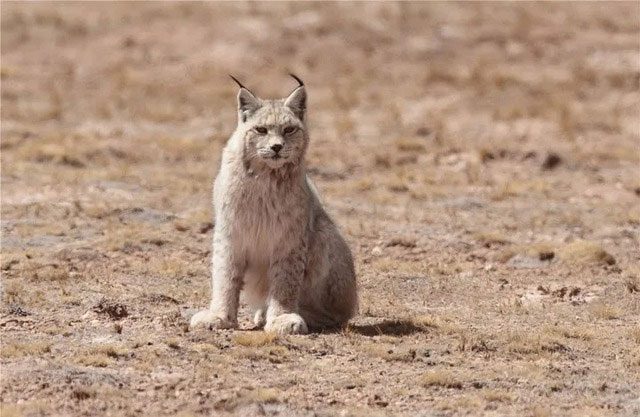In some areas with rich ecosystems and frequent wildlife presence, it’s quite normal to occasionally find injured animals and rescue them.
Over the years, countless animals have been rescued by humans, including protected species such as snow leopards, servals, red foxes, ibex, antelopes, and various birds, as well as more common animals.
Recently, staff from the Wildlife Resource Protection Station in Tuxi County, located in the city of Tianshui, Gansu Province, China, rescued a special animal. At first glance, it may appear to be a cat, but it is quite unusual, even resembling a wolf. In reality, it was a lynx.

Lynx can grow to a weight of 18-32 kg and a length of 90-130 cm when fully grown.
The lynx is typically found in Tuxi County, Tianshui City, and the local residents are quite familiar with this species, which occasionally hunts poultry and livestock. Recently, some farmers in Ma Chang Village, Dang Cheng Luan Town discovered a small lynx in their pasture, seemingly injured, lying there and refusing to leave when approached. Therefore, the farmers immediately contacted the local wildlife resource protection station.
Upon arrival, the staff found a lynx in a spacious area. Although it appeared relatively healthy and muscular, it was clear that this male lynx was about two years old and still immature, as male lynxes reach maturity later than females, around 30-34 months of age.

It remained still but acted aggressively when approached. After examination, it was found to be injured, but without any broken bones. It is speculated that it may have slipped and fallen from a cliff while hunting, causing damage to its sciatic nerve, which left it unable to stand. The staff then took it back to the rescue station.

After several days of care, the young lynx has recovered well, with both its food intake and physical condition returning to normal. The staff indicated that the next step would be to continue rehabilitating the young lynx until it fully recovers and is eventually released back into the wild.
Short tail, small ears, and tufted hair resembling antennas, with wolf-like features among cat species
The lynx is a species of cat with a quite unique appearance; overall, it resembles a cat but has a slight resemblance to a wolf. Among the 40 members of the modern cat family, it is the most wolf-like.
Lynx is actually a general term for the lynx species. All four species belonging to the genus Lynx can be referred to as lynxes, and the lynx we commonly refer to usually denotes the Eurasian lynx, which is the largest of the four species in the Lynx genus, capable of growing to a weight of 18-32 kg and a length of 90-130 cm when fully grown.

The tufts of hair on a lynx’s ears have significant utility.
The lynx has a robust body, short tail, long and thick limbs, and particularly wide feet. This is advantageous for their movement and hunting in snowy environments, as lynxes prefer cold climates and are primarily distributed in northern Eurasia. Their cheeks usually have long tufts of fur that hang down.
On the lynx’s wide ears, there are two erect tufts of hair that resemble antennas. In reality, these tufts serve a significant purpose. The ear flaps and hair tufts can move towards the source of sound at any time and help capture sound waves; without these tufts on their ears, the lynx’s hearing would be greatly affected.
A fierce temperament and strong fighting ability
As a medium-sized cat, it possesses a fierce temperament and a strong fighting ability. The most famous record of this species is its ability to confront European wolves, even decimating entire wolf litters and forcing wolves to face extinction in many regions.
Ecologists from the Belarusian Academy of Sciences conducted long-term ecological research in the Nalipoki Forest in Central and Western Belarus and found that Eurasian lynxes in the forest often actively attack and kill local European wolves, particularly seeking out wolf dens and slaughtering all the wolf pups inside.

The fighting ability of male lynxes is very strong.
The fighting ability of male lynxes is quite formidable; female wolves and wolf pups are generally no match for them, with only mature bears and male wolves capable of resisting them. However, lynxes are quite intelligent and will never proactively attack male wolves.
From April to September each year is the warm season in the Nalipoki Forest, during which many small mammals are present, and solitary wolves tend to hunt more effectively. Therefore, during this season, most European wolves tend to hunt alone. The number of solitary wolves even surpasses that of pack wolves, providing an opportunity for lynxes to ambush them.
In European forests, as well as most forests in China, there is generally a lack of large predators such as tigers and leopards, which are larger and have more formidable fighting abilities. As a result, lynxes have become the “kings” of the forest.





















































